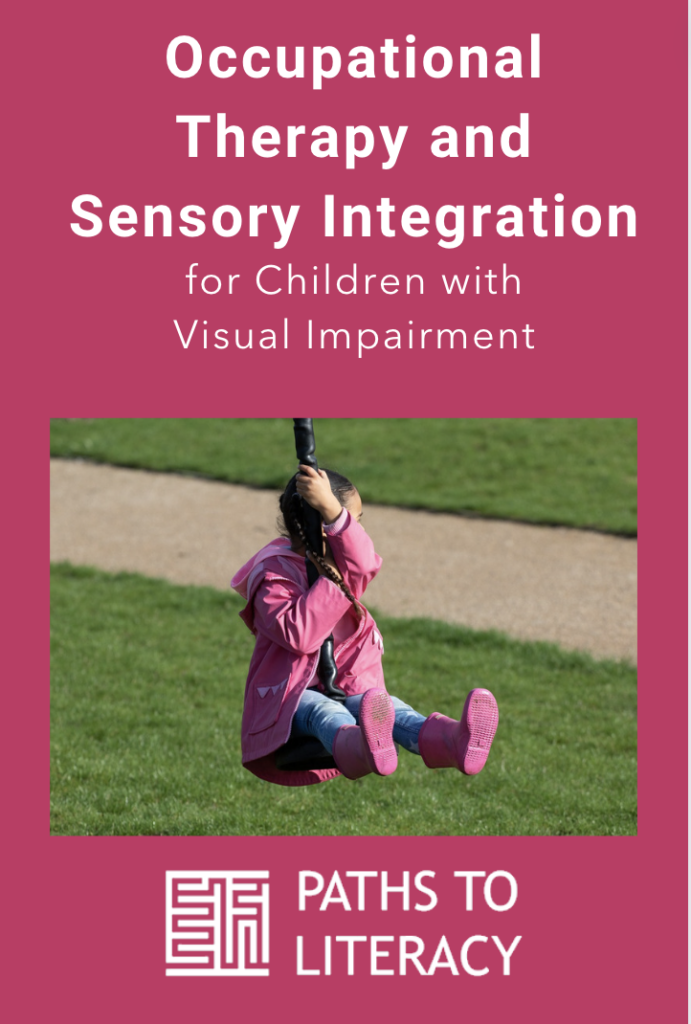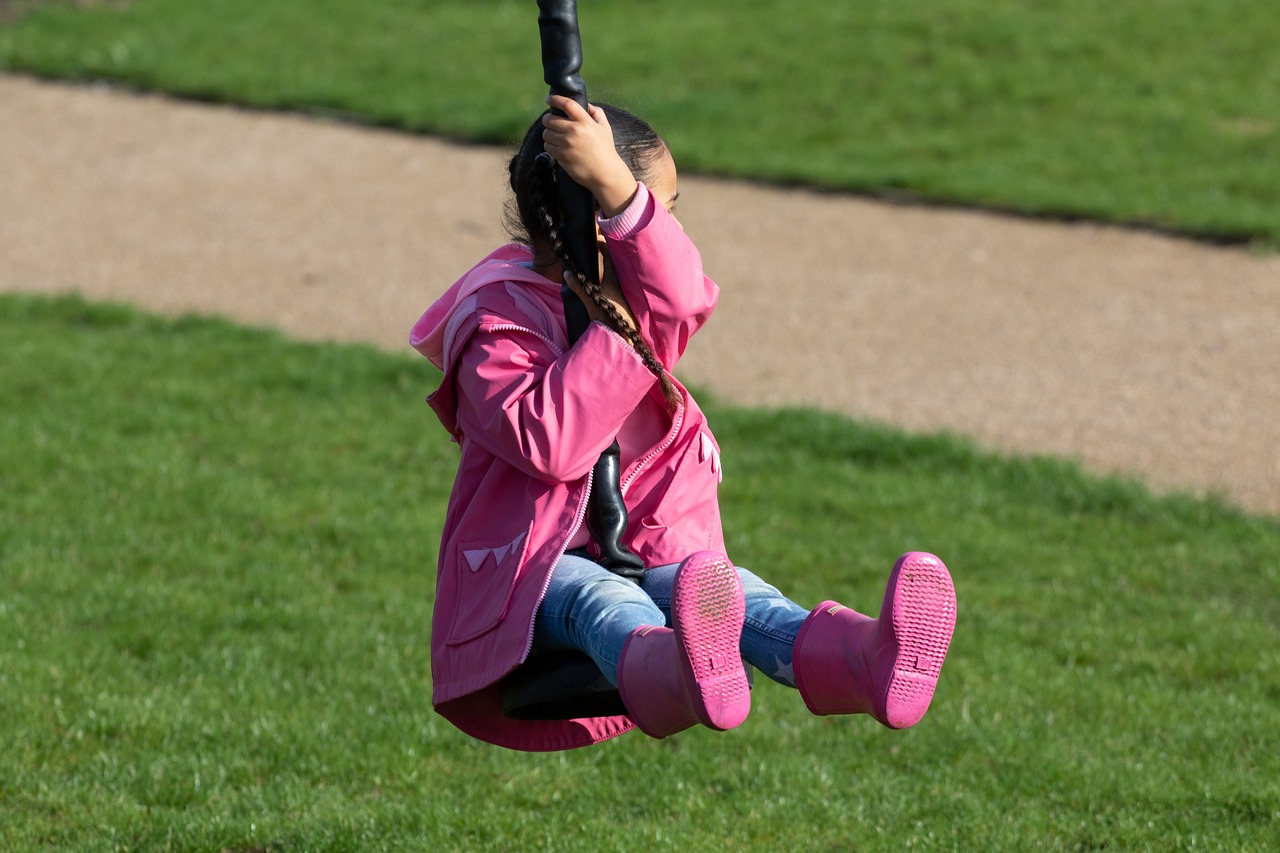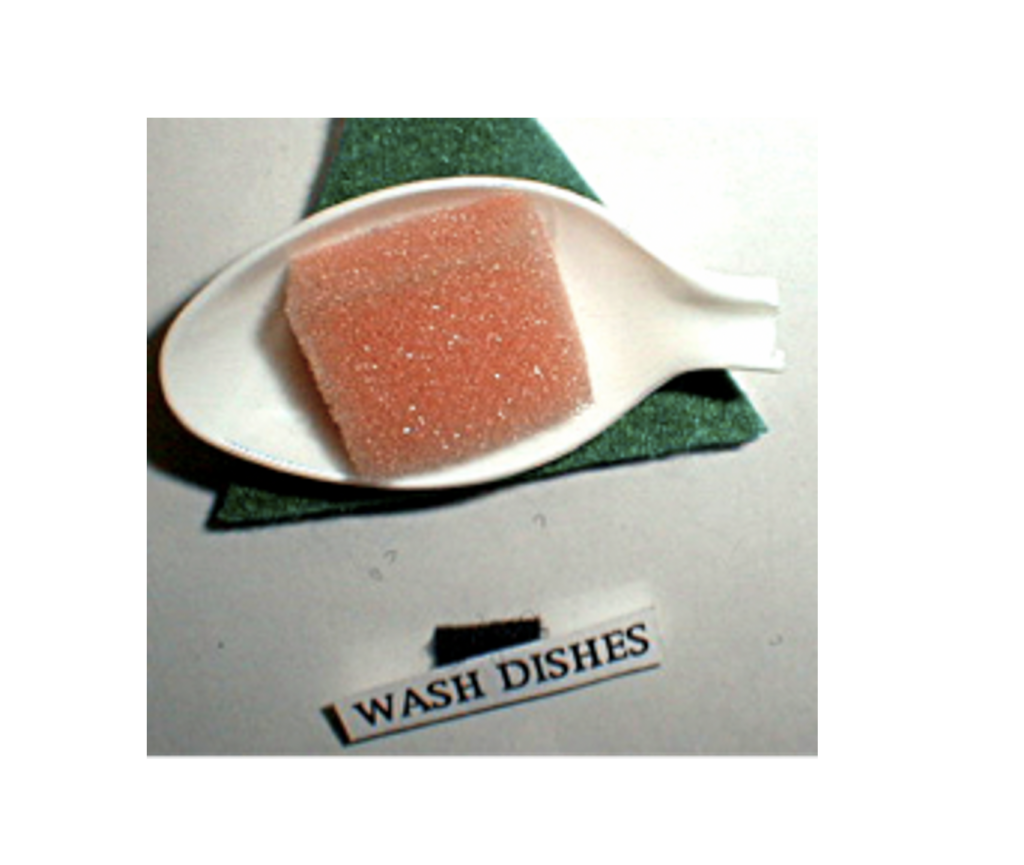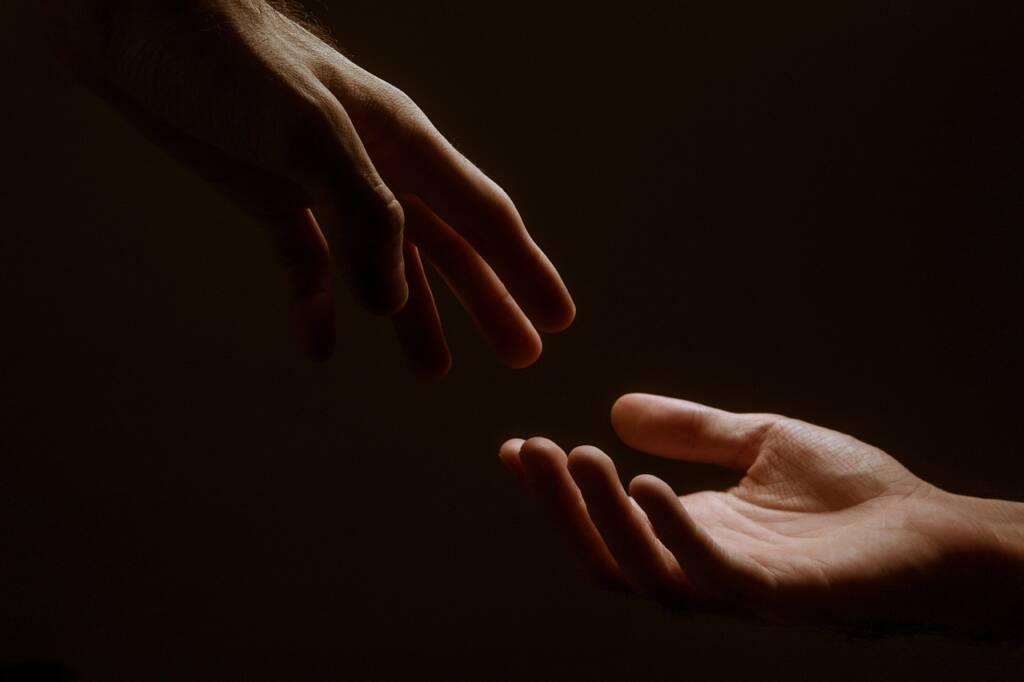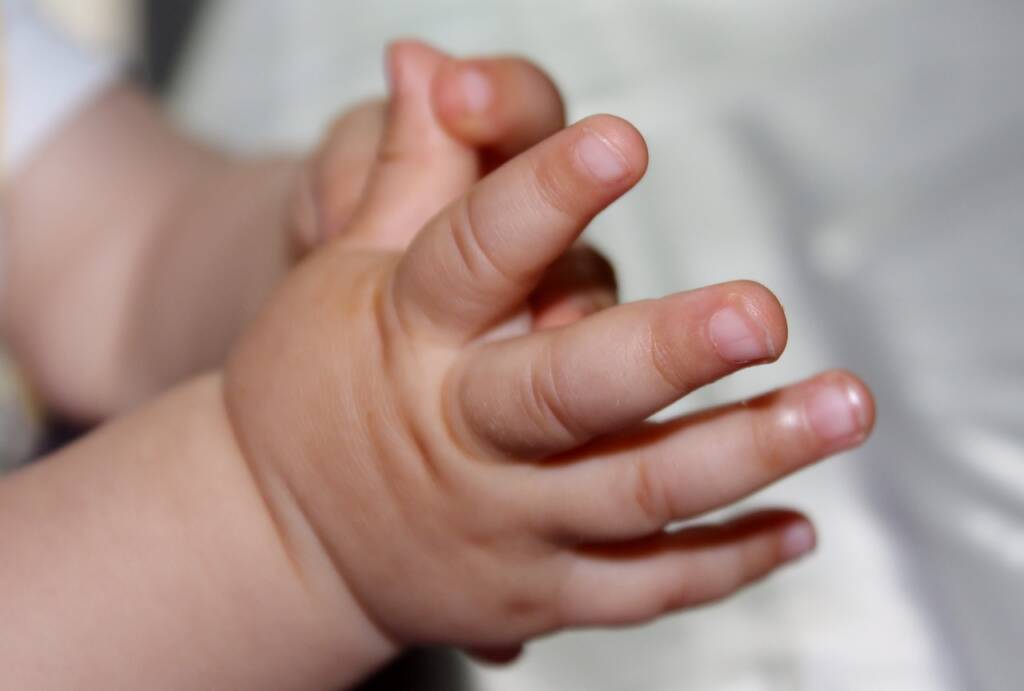By Lisa Ricketts, OTR, Texas School for the Blind and Visually Impaired
As an Occupational Therapist at TSBVI, I am inspired to learn all I can about the theory of sensory integration by Dr. A. Jean Ayres. As a specialist for children with visual impairment and multiple disabilities, I am studying the impact of vision loss on the other senses and overall developmental progression. I also work at a sensory integration clinic here in Austin for the treatment of autism and sensory processing disorders.
I am lucky to be surrounded by expert teachers, therapists, school psychologists, and, most importantly, by my students, whom I learn from every day. My purpose here is to share terminology, explanations, and problem solving ideas with students, parents, and teachers.
Sensory Integration and Motor Control
The author and initial researcher of the Sensory Integration Theory used in Occupational Therapy is Dr. A. Jean Ayers. Her work presents an expansive theory describing how the brain and the body processes, organizes, and integrates the sensations received through sight, sound, touch, taste, smell, body position, and movement.
Students with visual impairment rely on hearing, touch, body position and movement sensations for everyday activities. Normally these activities are directed by vision. Sensory Integration theory provides a framework to help emphasize and explain the role of all our sensory systems.
Touch
The tactile system processes touch experiences felt through the skin as light touch, firm touch or pressure, static touch, moving touch, temperature, pain, and comfort. There are two primary functions of the tactile system. One is protection and the other is discrimination.
The protective touch function is neurologically bound to the limbic system of the brain. This system is described as the emotional control center with direct connections to the primal flight or fight responses. The protective function of the skin is reflexive and primarily unconscious with touch sensations automatically categorized into calming, soothing, familiar sensations, or into danger reactions.
The discrimination functions of the skin are conscious, cognitive tasks that are learned through experience. These include touch localization, recognition, and stereognosis. Localization refers to knowing where on the body one is being touched. Tactile recognition is required to learn characteristics of objects such as size, shape, texture, and the weight of items. Stereognosis is object recognition through touch.
Signs of tactile system imbalance:
- Reacts negatively to touch, does not like being picked up or hugged.
- Does not like being touched and may rub or press on his or her skin after being touched.
- Startles easily.
- Inability to feel touch immediately and responses are delayed.
- Extraordinarily high or low tolerance for pain.
- Does not like certain clothing or tags in clothes, and wears clothes for the wrong season.
- Does not like band-aids or stickers on skin.
- Uncomfortable wearing shoes or socks, or unwilling to walk barefoot.
- Does not like brushing hair or teeth, or cleaning and trimming nails.
- Avoids certain foods because of texture, or does not chew food well.
- Rejects touching messy materials and will not handle clay, mud, shaving cream.
- Washes or wipes hands often.
- Uses fingertips instead of the entire hand.
- Has a hard time sitting still.
- Is poorly coordinated, is a heavy walker, or walks on toes.
- Craves touch and may over-touch others or objects.
- Doesn’t notice when hands or face are messy.
- Doesn’t notice when clothes are twisted, or when feet are not well placed in shoes.
Body Position
Proprioception refers to body position sensation and is required to regulate movement and posture. This system allows us to feel the position of our limbs for motor control and to determine the amount of strength needed for specific actions, or graded force. It is an unconscious feedback system between the muscles & joints of the body and the brain. The receptor stimuli is the bending, straightening, pulling, and compressing of the body’s joints between the bones. Proprioception is neurologically connected to both the tactile and the vestibular systems.
Signs of proprioceptive system imbalance:
- Has difficulty planning and executing motor tasks for gross or fine motor activities such as getting on or off a bike or riding toy, climbing on/off playground equipment, buttoning clothes, turning on/off a faucet, pouring, etc…
- Has a high need for jumping.
- Enjoys hanging by the arms.
- Tends to lean on or hang on people or furniture.
- Enjoys falling down.
- Assumes odd body positions.
- Is clumsy and plays roughly.
- Breaks toys often.
- Grips a pen or pencil too loosely or too tightly.
- Has difficulty with fine motor skills for picking up small objects.
- Did not crawl much during early development.
- Difficulty grading muscle force—muscle exertion is either too much or too little to manipulate objects and perform tasks.
- Puts non-food items in the mouth, chews on clothes, or grinds teeth.
- May hit, pinch, or bite self or others.
Movement
Vestibular processing refers to movement and balance sensations. These are the combined functions of the semicircular canals of the inner ear, basal ganglia, cerebellum and the cerebral motor cortex. This system regulates the feelings of motion such as balance, acceleration, deceleration, starts and stops, direction, rhythm, and creates and stores patterns of movement. The hair cells inside the semicircular canals are activated according to position and movement of the head in relation to gravity. Vestibular processing is likely to be impacted by auditory impairment.
Signs of vestibular system imbalance:
- Difficulty maintaining balance and controlling the speed and direction of movement.
- Poor balance reactions such as protective extension or righting responses.
- Poor spatial orientation and is easily confused by directions.
- Fears being upside down or tipped sideways.
- Is anxious when feet are not touching the ground.
- Is anxious about walking up or down inclines.
- Is anxious walking up or down stairs.
- Rejects unfamiliar movement activities and is afraid to move backwards.
- Is afraid of movement, or is gravitationally insecure.
- Gets motion sickness easily.
- Is anxious about swimming.
- Seeks out gross motor movement and may have a very high tolerance to spinning.
- Possible extraneous or non-purposeful movements.
- Can’t sit still—craves movement.
- Likes to fall without regard of safety.
- Difficulty with self regulation.
- Needs to be moving but this may interfere with listening and interacting.
- Needs to be moving in order to listen or be attentive.
- Needs to jump or spin.
- Likes inverted upside down position.
- High or low muscle tone—the vestibular system combines with the proprioceptive system to regulate muscle tone.
Impact of Sensory Integrative Dysfunction
Sensory integration is the organization of sensation for use. Countless bits of sensory information enter our brain at every moment, not only from our eyes and ears, but also from every place in our body. Sensations are food for the brain that provide energy and knowledge needed to direct our body and mind. The greatest development of sensory integration occurs during an adapted response; this is a purposeful, goal directed response to a sensory experience. In an adaptive response, we master a challenge and learn something new. At the same time, the information of an adapted response helps the brain to develop and organize itself. The first seven years of life our brain is a sensory processing machine nourished by having fun through play and movement. The child who learns to organize play is more likely to organize activities of daily living.
If the brain does a poor job of integrating sensations, this will interfere with many things in life. The brain is not processing or organizing the flow of sensory impulses in a manner that gives good, precise information about the body or the world. Learning is difficult and a child often feels uncomfortable and cannot easily cope with demands and stress. If a child is blind or visually impaired this difficulty is compounded when attempting to make sense of his or her world.
Complex medical problems associated with many syndromes at birth may result in delayed sensory integration development. This delay may be due to either neurological disorders or medical issues creating limitations to sensory experiences that nourish the brain. Symptoms of irregular sensory processing in the brain are different for each child. There are three basic sensory systems that impact how a child learns and behaves in the environment. They are the tactile, vestibular, and proprioceptive systems. The following outline is a brief description of symptoms observed in each of the three systems when dysfunction of sensory processing is present:
The Tactile System (Discriminative versus protective touch)
Dysfunction in the discriminative system may result in:
- Difficulty with fine motor skills impacting daily living skills.
- Problems articulating sounds due to inadequate information from touch receptors in and around the face and mouth.
- Difficulty with accurate tactual perception and basic concepts.
- Impaired awareness of body scheme.
- Inefficiency in how one tactually explores an object or the environment in order to gain additional cues which give meaning about the object and about the environment
- Contributes to somato dyspraxia – a specific disorder in motor planning
Dysfunction in the protective system may result in:
- Interpreting ordinary contact as threatening
- May be frequently in a state of Red Alert
- May react with flight/fright/or fight, either physically or verbally.
- Being labeled tactually defensive
- Some children feel too much and feel too little. Some may have a high tolerance for pain because they do not accurately feel what is happening to them.
- They may not react to being too cold or too hot because they are unaware of temperature.
Proprioceptive System
The proprioceptive system is our unconscious awareness of muscles and joint positions that constantly send information to the brain to tell us our body position and posture.
Dysfunction in proprioception results in: Slower body movements.
- Clumsier movements.
- Movements involve more effort.
- Difficulty grading muscle force—muscle exertion is either too much or not enough when manipulating objects or performing activities.
- Difficulty feeling the weight of objects
- Difficulty planning body movements while performing gross or fine motor activities (getting on or off a riding toy, buttoning clothes, turning on a faucet, etc.)
Vestibular System
The vestibular system responds to the position of the head in relation to gravity and accelerating or decelerating movement, and linear or rotary movement. Vestibular receptors are the most sensitive of all sense organs and are major organizers of sensations to all other sensory channels.
The location of the vestibular system is in the inner ear called the “labyrinth.” Abnormalities of the ears and hearing loss are common features in many syndromes, the influence of this system plays a major role in the developmental milestones of sensory processing and gross and fine motor skills.
Influence of vestibular system on eye and neck muscles:
- Ability to visually follow objects.
- Ability to move eyes from one spot to another.
- Ability to interpret—is it an object, our head, or our whole body that is moving?
- Ability to interpret—is our head moving or tilted?
- Ability to maintain a stable visual field.
Influence of vestibular system on muscles of the body:
- Generates muscle tone.
- Helps us to move smoothly, accurately, and with proper timing.
Influence of vestibular system on postural and equilibrium responses:
- Maintains balance.
- Controls spontaneous body adjustments.
- Facilitates co-contraction of muscles.
- Elicits protective extension and other balance reactions.
Other areas influenced by the vestibular system:
- Reticular Interactions – responsible for arousal of nervous system (calming effects vs. arousal effects); the vestibular system keeps the levels of arousal balanced.
- Relation to Space – perception of space; position and orientation within that space.
- Auditory Processes – helps the brain process what is being heard; vestibular disorders slow down speech development.
- Emotional Development / Behavior – for emotions to be balanced the limbic system, which generates emotionally based behavior, must receive well modulated input from the vestibular system.
Two types of vestibular disorders
Under-reactive vestibular system:
- Child may tolerate an enormous amount of movement (merry-go-round, swinging, spinning) without getting dizzy or nauseous.
- Has poor integration of the two sides of the body.
- Is easily confused by directions or instructions.
- Hands and feet do not work well together. Poor bilateral coordination and upper/lower body coordination.
Over-reactive vestibular system:
Child is hypersensitive to vestibular input resulting in:
- Gravitational insecurity – a feeling of anxiety or stress when assuming a new position, or when someone else tries to control movement or body position; swings, merry-go-rounds, and other playthings that move the body in non-ordinary ways may feel terrifying.
- Intolerance to movement – discomfort during rapid movement; the child is not necessarily threatened by movement, but it causes uncomfortable, or possibly nauseous feelings.
Evaluation and Intervention
If there is suspicion that a child has dysfunction with sensory motor processing, an evaluation can be conducted by either an occupational therapist or physical therapist. Evaluation consists of both standardized testing and structured observations of responses to sensory stimulation, posture, balance, coordination, and eye movements. The therapist who conducts the testing may also informally observe spontaneous play, and may ask the parents to provide information about their child’s development and typical behavior patterns. A report will follow the evaluation that provides test results and interpretation of what the results indicate. The therapist will then make recommendations regarding the appropriateness of therapy using a sensory integrative approach.
Providing intervention based on the principles of sensory integration theory requires that the therapist be able to combine a working knowledge of sensory integration theory with an intuitive ability to gain a child’s trust and create the “just right” challenge. Therapy will involve activities that provide vestibular, proprioceptive, and tactile stimulation, and are designed to meet a child’s specific needs for development.
Activities will also be designed to gradually increase the demands upon a child to make an organized, more mature response. Emphasis is placed on automatic sensory processes in the course of a goal-directed activity, rather than instruction on how to respond. Parent or teacher involvement is crucial to the success of a child’s development and improved sensory processing. The therapist may make suggestions to the parent and teacher about how to help a child in the home and school environment.
Sensory Integration and Sensory Motor Activities
Tactile Play Activities
Try the following ideas for tactile stimulation. If your child or student will not touch materials with their hands and fingers, don’t push. Try letting them touch with a spoon or fork or straw, or try wearing dish or other gloves to get started. Keep soft cloths and water ready for clean up. Provide wash cloths for frequent hand wiping as needed. If touching bath foam or finger paint is too stressful, put a small amount into a zip lock bag and hold and squeeze the bag. Begin play with dry textures if wet, messy materials are too stressful.
- Try water play outside of demanding situations such as bathing and tooth-brushing. Use various textures of washcloths, sponges, water toys, squirters, water guns. Water plants with a spray bottle. Clean and wipe tables or floors with sponges and a bucket of water. Play with cool and warm temperatures. Help wash dishes in warm water and rinse in cool.
- Fill large storage bins with dry beans or rice, encourage play in the bin with hands and feet. Hide small toys for searching, use cups and coffee cans for pouring, stir with large spoons, play with funnels and other kitchen toys. Pour beans or other textured material outside on the sidewalk and try to walk across.
- Use lotion for firm touch massage. Teach self massage. Remember that firm, deep touch is calming and organizing.
- Consult an OT or PT familiar with skin brushing and joint compressions. This is a technique recommended to help reduce tactile defensiveness with frequent, structured tactile and propriooceptive input.
- Art activities: finger paint, modeling clay, glue and glitter, glue and sand. Make art with pasta and glue or string and glue. Glue designs on paper.
- Create feely boxes or bags with a variety of textured materials and various textured toys. Fill with fabric swatches to discriminate, label or match. Fill with items to identify and describe, like wooden puzzle shapes, beads, etc.
- For hand fidgets, keep a fanny pack available with a variety of textured items inside. For squeezing try stress balls, thera-band, thera-tube, and stretch toys. Use noisy squeeze toys for play.
- Cooking activities – mixing and stirring cookie dough, pushing cookie dough into cookie cutters. Measuring and pouring ingredients. Make pudding and jello. Sift flour.
- Carefully introduce various textures for exploration and play. Place materials on a cooking sheet or plastic placemat – shaving cream, bath foam, lotion, play dough, silly putty, toy slime (gak). Introduce toys for ideas such as a “bath foam or shaving cream car wash.” Drive toy car through shaving cream or draw shapes and write designs with fingers.
- Play dough – use rolling pin, cut dough with safe/dull scissors, practice cutting with knife and fork, use cookie cutters and molds, hide items to search for (coins, marbles, pebbles, or small toys).
- Sand play – use cookie sheet, cover table with plastic, or play outside. Use clean dry sand and a spray bottle with water for added moisture. Play with cookie cutters or toys, such as plastic dinosaurs or cars. Write in sand, or build shapes or a sand castle.
- Fabric and texture play – use carpet squares for walking on; space out squares to find with toes. Use swatches of various types of fabric (corduroy, satin, velvet, fake fur). Play and walk on egg crate foam; also use foam to roll up inside “taco or hot dog game”
- Trace raised lines of tactile maps.
- Any pushing through the hands will help. Such as on the tummy over a yoga ball holding body weight through arms and hands. This “prone weight bearing” is very helpful for tactile tolerance, general strength, postural control, and proprioceptive/vestibular input.
- Theraputty is a resistive exercise material used by therapists. Colors vary according to resistive strength. Hide toys, coins, or buttons inside for tactile searching. Keep in a sealed container and be careful not to get on clothes or carpet. (It will stain and stick!)
- Try vibration with massagers or vibrating mats or toys, squiggly pens, or electric toothbrushes.
Proprioceptive Play Activities:
- Move as much as possible! Jump on a trampoline or a mini-tramp. Bounce on yoga balls. Outside play on all kinds of equipment for supervised climbing and up and down a slide.
- Prone weight bearing – such as four-point crawling or on the stomach over a therapy ball holding weight through arms and upper body. If strong enough, try “wheel barrel walking.” (Prone weight bearing is very important for postural strength, upper body and arm/hand strengthening, and reflex inhibition).
- Scooter board activities: for small size scooter boards sit cross-legged and propel with hands. Ideally have long size scooter boards available for riding on the tummy to propel with arms. Add wrist weights for increased proprioceptive and pressure sensation. Try all directions, forward backward turning full circles left to right. Push off from a wall to propel backward. Crash into cardboard brick walls or stacked boxes. Ride scooter board down a ramp to crash into toy bowling pins or crash into a large pillow. Ride a scooter board short distances to search for and pick up toys or bean bags and return. Try prone on a scooter board with a large rope to pull forward for hand over hand reach.
- Add weights to items for more feedback. For example add weight to a cane or pre-cane to help keep it in the correct position and to provide greater pressure feedback. Small size wrist and ankle weights are available – these can be worn for extra proprioceptive feedback and can also be added to other items. Ask OT/PT if a weighted vest might be helpful. Weighted blankets are available or try heavy quilts. Neck and shoulder wraps are available in drug stores sometimes designed to go in the microwave for heat – these can be used without heating around the neck or held in the lap. Weighted sweatshirts can be made easily by sewing seams shut after filling with dry beans or rice or sand. Wear loosely over the shoulder and back or on the lap.
- Hang from a trapeze bar or chin up bar – if this is too scary have a step stool to stand on and feel the pull through the arms and hands without having to support full weight.
- Teach simple isometric exercises such as wall push-ups and chair push-ups. Teach modified push-ups and sit-ups.
- Practice pouring over the sink or outside from heavy containers – gallon and ½ gallon jugs. Practice pouring with pitchers filled with sand or other dry materials.
- Use squeeze horns such as a bike horn. Have a variety of stress balls—there are many different types and interesting toys for squeezing. Wring water from sponges and cloths. Squeeze bottle glue and squeeze bottle puff paints for art. Use spray bottles to water plants or keep spray bottles at sinks or in tubs for play.
- “Zoomball game” is a toy with a plastic ball strung on two ropes. The ropes have handles on both ends and the object is to pull arms apart quickly to send the ball to your partner. Arms are spread quickly and closed quickly for a successful pass.
- Try using tools with supervision – hammer, screwdriver, pliers, or sanding wood. Use dull/safe scissors to cut heavy paper or cardstock.
- Pull with a partner for tug-o-war games. Pull a friend in a wagon or push/pull a laundry cart.
- Roll in foam pad or quilt for deep pressure games—“the hot dog”, the “burrito”, or the “enchilada.” Use rhythmical touch with hands or roll over with a therapy ball. Try weighted balls such as a medicine ball (weighted PE ball).
- Climb and lie under large pillows, bean bags, mattresses, or cushions. If other students are available have them try to crawl across and then take turns being underneath.
- Throw balls against a wall. Throw to the left and right sides, forward and backward and overhead.
- Vestibular Play Activities:
- Sit and bounce on yoga balls. Try prone (on the tummy positions) and supine (lying on the back). Give support to lie back and stretch the back and hang the head backward.
- Stationary bike and treadmill exercise. Ride tandem bikes. Help a younger child ride tricycles and bikes with training wheels for left/right integration and reciprocal control.
- Ride stand up scooters (with handle bars) and support. Roller skate with hand hold support or put a large belt around the body to hold on to.
- Bouncy shoes or “moon shoes”—these are large toy shoes that fit over regular shoes to bounce, jump, and walk with.
- Try as many types of swings as possible—standard playground swings, platform swings, bolster swings, pogo swings (a bouncy and rotational swing) and hammock swings.
- Use rocker boards and spin boards. Both are low to the ground and the rocker board can be used in sitting or standing with support. Try four point position (crawling position) or tall kneel position with support. The spin board is only used in sitting!
- Try a T-stool. Try to keep balance while throwing a ball against the wall.
- Rolling games or races; rolling down or up hills outside. (Rolling is terrific for tactile, proprioceptive, & vestibular input and reflex inhibition).
- Practice balancing on one foot. Hop with feet together and hop on one foot. Jump one foot to the other. Practice marching, running, or stomping in place.
- Try very low balance beams or tandem walking in a straight line (heel toe, heel toe). Use hand hold support, hold onto a hula hoop, or dowel – add a bean bag to balance on the head for greater challenge. Place a ladder on the floor and try to step across separate rungs.
- Use an inner tube to step or hop inside and walk around the edges for balance.
- Balance in tall kneel position or half kneel. Toss a ball against the wall while holding balance or keep a bean bag on the head.
- For smaller feet, place feet in shoe boxes to slide along the floor. Try walking with swim fins.
- Directional movement practice – use a heavy wooden chair for sit/stand commands, in front/behind move to the left/right sides, circle the chair, three steps forward/backward from chair. Add music, slow and fast movements. Combine with Simon Says and Red Light Green Light games. Practice directional controls for facing the front of the room, the back, & either wall. Practice facing north, south, east, and west. Try quick change games for moving from sitting to standing to four point to stand on one foot, etc. Practice turning toward sound.
- Parachute games for up/down arm movements and shaking. If a group is available try having kids crawl under to the other side. Add a light weight ball and bounce the parachute to toss the ball over the side.
Heavy Work Activities:
Heavy work tasks are any activities that require whole body movement and resistance such as carrying heavy objects or carrying large size boxes; pushing through heavy doors; pushing a grocery or work cart; pushing a laundry basket; pulling a friend in a wagon; helping to move furniture; vacuuming—any activity that requires resistance with movement.
Heavy work activities are thought to provide the longest sensory effect with combined benefits of proprioceptive and vestibular stimulation (heavy work routines potentially have a calming effect on the nervous system for 4-6 hours).
This article was originally published by Texas School for the Blind and Visually Impaired (TSBVI) in SenseAbilities (Fall 2008) and is reprinted here with permission.
